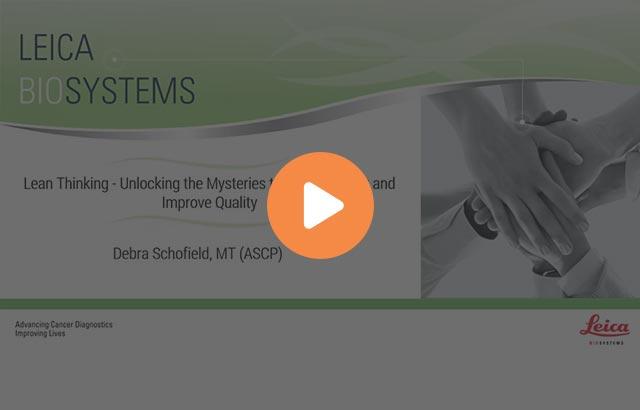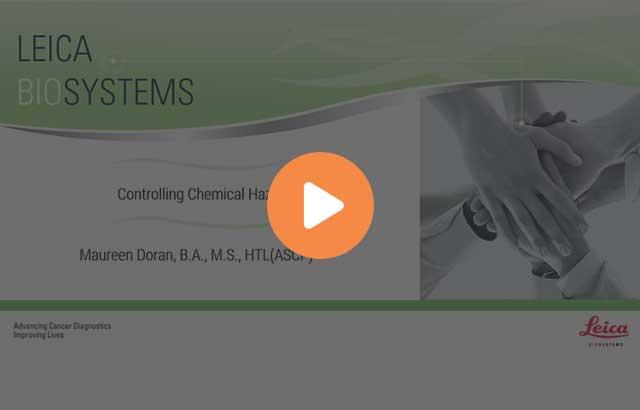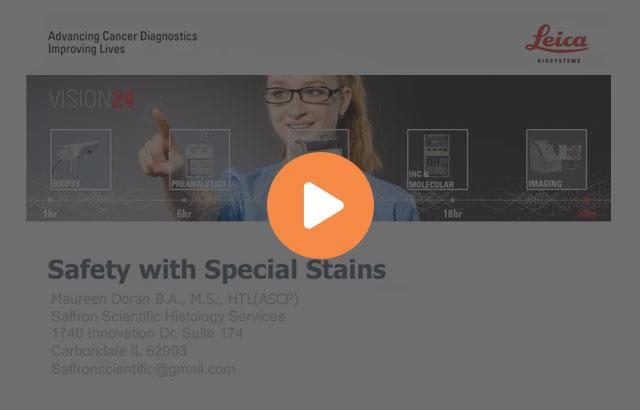Cytogenetics: A Blueprint for Building Quality, Interconnected and Efficient Laboratory Process

April Schrank-Hacker will offer a holistic look at the Cytogenetics laboratory workflow to increase confidence and accuracy in the final diagnosis. She will discuss new perspectives on creating optimized, safe and reliable workflows that your lab could implement today to positively effect patient care tomorrow.
Learning Objectives
- Explain how the use of a three-pillar approach can help Cytogenetics laboratories reach their quality and efficiency goals
- Demonstrate how to optimize the use of human and technical resources
- Describe how this approach improves patient safety
Webinar Transcription
Today I want to present a blueprint for building a safe, interconnected, and efficient processes within the cytogenomics laboratory that can positively affect patient care and experiences.
Learning Objectives
Learning objectives will be conceptualized around a three-point plan that labs can use to increase accuracy and diagnostic confidence by reaching quality and efficiency goals, optimizing current people and processes in cytogenomic workflows using a lean approach, and describe how implementing these three points can improve patient safety. The PowerPoint will be available in Pathology Leaders after the presentation for review and follow-up. My presenter information will be on Pathology Leaders as well.
My Story…Total Disruption
I am very passionate about patient care and understanding how the work we do every day is integral to their experience. I want to share a story with you.
Everyone we know has someone in his or her life that has been touched by cancer. I spent my career in the cytogenomics laboratory doing both research and clinical work. One day I found myself on the other end of that process. It was the longest most dark ten days of my life while I waited for those biopsy results to come back. I wondered what I was going to do if I really did have cancer, if my children would have to grow up without me. How will my husband care for them and what about my work? All these things pierced my every thought and colored my emotions for days. Disruption in the form of one small word, cancer, entered my life. Fortunately, my results came back, and I was fine, but I will never forget that patient experience. I’m very mindful of the anxiety that patients face. Today, we, in the labs must always strive to continuously improve our processes and service to our patients.
Cytogenomics
I always think of Rome when I’m looking at doing an optimization process. The Romans were expert engineers and they always used a three-tired approach to building structures that have stood the test of time:
- Foundation are providers on the ground, in the lab getting the work done;
- Structural Support is the three-pillar process of quality, interconnection, and optimization that supports the systems;
- Roof is the apex or the uppermost point, the patients and their care.
By honoring the people, the process, and the patients we can build a safe, interconnected, and efficient laboratory process that yields high trust in diagnostic reliability and patient experience.
Engineering Success
Working in the cytogenomics laboratory is a wonderful fulfilling job led and performed by teams centered on excellence and compassion. It can also sometimes be fraught with stress and chaos caused by high volumes of samples coming in at once, unplanned stat samples, complex work flows that are mostly manual, and diagnostic pressures downstream all containing opportunities for error that can impact patient safety and operational efficiencies. The message I hope to convey today is by thinking about the three pillars; quality, interconnection, and efficiency, cytogenomics laboratories can build a safer, streamlined, and more reliable diagnostic pathway.
Why is This Important?
Cytogenomics is a high complexity testing environment requiring trained expertise in processing samples that obtain high-quality reproducible results. This enables clinicians to make proper and effective treatment decisions for their patients in a specific timeframe, all the while understanding that a patient, also, is waiting for us.
This slide is an example of a process map or a workflow for performing FISH assays. I wanted to highlight all the many steps it takes for us to do one single process and this is a high-level view of the complexity of the steps necessary to complete the processes.
The Lab Lens: The 3 Pillar Process
In using the three-pillar process a lean mindset must be adopted. Lean is a method for describing how work is done by managing workflow, eliminating waste, and managing performance over time. This multi-perspective lens guides the three pillars. The idea is to walk through every step of a process with a questioning eye of quality. Look for error-prone steps, something that may be impacted by automation, or realigning a current use in a new way. Look at the process down the diagnostic pathway for a new interconnection. Is there a current instrument or application that can be leveraged in a new way to make this more efficient? Is there a new idea to help bridge siloed or individual processes to work together? Optimize efficiency by putting all the steps together into a new streamlined way, monitor over time, and adjust as needed.
Lean: 8 Wastes in the Laboratory
Lean has three aims that describe how work is done. Conventional cyto labs can sometime use a “hurry up and wait” or a batch and queue model where large volumes are run, and others are left to wait until more of the same type arrives. This leaves a lab vulnerable to hot spots of work production and analysis that leads to overloads on instrumentation, techs, and sometimes errors. Lean allows us more of a continuous flow of work which is achieved by leveling large amounts of work over a consistent time to decrease the unevenness of large batches of work and overburden on technologists and instruments. This helps to eliminate waste and it is continuous improvement where performance is managed and measured over time, but adds value as seen by your customers, the administration, the clinicians, and patients.
Lean is a way of thinking about eliminating wastes that occur during your daily work in the lab. There are several ways waste can occur in the laboratory.
- Defect or rework would be incorrect patient IDs on labels, re-dropping, or relabeling slides or slides that turn up with poor quality.
- Overproduction is making extra sample slides or pre-labeling in excess of what is needed.
- Wait time is any time a sample sits inactive waiting for the next step in the process to happen.
- Talent is using technologists to do any other job than what they were trained for.
- Transportation is courier times, moving samples from station to station, any kind of unnecessary steps being taken outside that work.
- Motion is any movement of the person doing the test outside the workspace; walking around troubleshooting, picking up supplies, looking for things.
- Over-processing includes filling in extra log books, making copies, sorting, prioritizing.
- Inventory is having excess or not enough supplies at the workspace to complete the process.
A leveled flow lab can eliminate many different types of wastes. Eight are listed, but you can think about how many you are doing on a daily basis and create a more agile, faster throughput, and reliable cytogenomics.
Cytogenomic Workflow
In the lab we will look at these three main categories that we can access for high impact opportunities to use the three pillars of quality, integration, and efficiency:
- Specimen intake and accessioning;
- Specimen processing;
- Sample analysis.
Pillar 1: Quality
Quality is the foundation on which confidence in resulting stand. By using continuous quality improvement, we can build consistency through standardization that can reduce errors and provide reproducible results. Specimen intake and accessioning is an area where manual keystroke touches can result in data transposition, patient misidentification, and mislabeling errors. The use of barcoding and specimen tracking systems can significantly reduce the number of touches and keystroke entries increasing the safety of patient samples and results down the diagnostic pathway.
Sample consistency and slide quality is the hallmark of obtaining trusted results. Traditionally, many processes in the cytogenomics are done by hand. This includes flask and tube labeling during culture, slide making for chromosome analysis, and with the formalin fixed paraffin embedded tissue (FFPET) FISH, the use of automation for processing paraffin FISH samples decreases the technologist’s time and reduces the number of times required to touch and extra processing from rework and defects.
The use of automated paraffin processors and hybridizers ensures a consistent, reproducible, and traceable slide quality and increases the safety. Data such as patient ID, the program used, and the probes applied are automatically logged and can be tracked within the instruments and added to a continuous quality improvement program.
Digital imaging systems and slide scanners remove the variability and ambiguity of the quality of self-selection chosen for analysis as the digital system locates, selects, and records cell locations. This increases the specificity of location identification and is of importance if a doctor or clinician calls and wants a review that requires revisiting any of those cell analysis results. It provides a traceable and precise mechanism of review which can ensure quality and safety of that diagnosis. Many of these systems use remote analysis stations which offer a time savings of resources and time. Because microscopes are not required to perform the analysis, it eliminates manual scanning. These digital systems now have statistic utilities that easily mine data for monitoring quality measures, which adds a continuous quality improvement and gives us that opportunity to go back, track, trace, and mine the data.
As we look down the cytogenomics workflow at each of the three categories, we can see opportunities for error to happen. At intake, we have registration, handwritten requisitions, entering information by hand, visually looking up and down and matching back and forth and filling in logbooks.
At specimen processing we’re doing a lot of manual case data entry and putting it in the systems by hand. We’re entering results into case labels, doing manual completion of paperwork, so all the transpositions when we’re writing on each piece of paper in completing information of the case. Again, filling in log books.
In sample analysis we’re writing on the flasks, handwriting on tubes, handwriting slides, looking back and forth at written orders, transposing notes that are written, relabeling and doing stickers.
Common threads in all three areas are manual processes, hand-labeling, and data entry.
Pillar 2: Interconnection
Many times, people and instruments work in silos where they are not interconnected or integrated into a whole process that flows seamlessly. They have a lot of stops and starts like driving in the city versus driving down the highway. Integration of individual workflows can set the stage for a holistic end-to-end resulting.
Barcoding and specimen tracking systems can reduce lean waste of defects, extra processing, and overproduction yielding a positive impact on patient safety by ensuring every sample that enters the lab maintains the integrity of its rightful identification, providing clarity and transparency to its location, stage of process, and provides traceability of those movements. The process is both streamlined and trackable. By interconnecting automation during processing, we can work smarter and more efficiently.
By leveraging automatic harvesters, slide droppers, and stainers we can decrease lean waste of wait time, motion, and defects such as re-dropping poorly dried or stained slides, removes the variability amongst the samples that can help move the process more efficiently and effectively down the pathway into auto scanners and digital analysis systems. Ultimately all this decreases the time to resulting. Having slides that are of reproducible high-quality decreases handling time that a tech at the scope or an analyst needs. When upstream processes are linked together, the downstream result is increased quality, safety, and efficiency from end to end of the diagnostic superhighway.
Pillar 3: Optimization of Efficiency
The third pillar is optimization of efficiency. Optimization is about efficiency. Remember back to my story where those ten days I wondered what is taking so long? I knew enough about labs to make myself a little crazy but I came away from it with a renewed sense of urgency in my own work. It gave me a new insight into how I see things, how patients may see things, and now I constantly reimagine currently what is to what could be.
Utilizing lean expertise that helps eliminate the eight wastes in the laboratory allows for simplification of complex workflows and strategic interconnections of processes that increase quality, safety, and improved productivity. By cultivating this mindset, every step of the workflow can be examined to justify if it adds value to the process or if it’s just the way we’ve always done it. It invites us to inquire about what if, opening innovative operational options perhaps we hadn’t thought about before.
Summary
In sharing this three-pillar approach to building a high-quality, interconnected, and efficient workflow for the cytogenomics laboratory I hope that it’s helped you to reimagine the role of continuous quality improvement in your current systems. Consistency is the key to quality and quality builds confidence in the people, process, and patient experience.
Questions & Answers
Q: Does standardization reduce errors in the lab?
A: The more standardization we can have the more it’s going to decrease the variability of any process that you’re doing. If we can take the time to look at every single step and say do I really need that, why am I doing that, and is it done the same way with consistency every time, it decreases the variability through every step of the process, so you can get from beginning to end in a more reliable and consistent way.
Q: Are there solutions to help streamline or process?
A: There are a lot of different solutions. There are a lot of tools that can be used in lean and there are tools out there. The simplest thing to do is take out your SOPs, look at them and walk through every single step between what is written and what is being done. Make sure those two things are the same. Then question and say is this necessary, why am I doing it, what is the purpose of it, and does that step add value to your patient or to your customer base. If you turn that around as if you were the client you would say does this add value to what I’m doing. Keep that. If you are questioning it and it doesn’t add value, that’s something you might want to consider revamping.
Q: How can we better leverage our expertise for better production?
A: Being able to have the appropriate amount of people scheduled at the appropriate amount of time for the work when it’s at its apex is how we want to start leveraging our expertise. Having the people who are highly trained utilize their time by doing the cytogenetic analysis and hands-on work they are trained to do is utilizing them in their best way. Are there ways you could look at repositioning your lean waste to accommodate to having those techs doing more efficient work? By doing that, you’re positioning them to do what they do and eliminating some of the things they shouldn’t do. By consolidating the lean waste they’re able to do a lot more processes they are trained to do.
Q: Can you give us specific examples of how these tools were implemented in an actual lab?
A: I have had some experience especially working with the automatic processors. We were able to look at how we were doing things by hand and then look at when we were utilizing processors. We were able to move away from doing everything by hand and putting things in the paraffin processors. We were able to reutilize a lot of tech time and decreased the amount of rework. The quality was so on-point that the rework was significantly eliminated from our work process. We were able to reallocate time and resources that were being overused and put them back into the system to make things better and more effective.
Q: Is there any software that can arrange chromosomes at their right position automatically in karyogram?
A: There are different software you can use to help you line up your karyoplates and make sure all your chromosomes are in the right position that do really well. These are the digital imaging systems that are highly trained instruments. The software will help you read your cell images and some places want to look at them, especially with the FISH, and use them as a second reader. That helps you align your things exactly where you think they should be, and if you have to rearrange them you can do that. They’re very smart and they’re very helpful for doing makeshift karyotyping on the digital imaging systems.
Q: What are the main challenges to implementing these lab improvements and did you find an effective way to overcome them?
A: Change can always be challenging. If you have that approach of re-imagining what you are currently doing and saying is there another way, go back and revision what you are currently doing and think about it in this new mindset of looking for waste. Flatten out those workloads coming in and remove the anxiety and chaos by setting them up to go down this line of smooth flow and keep it flowing.
Q: What are the most impactful steps to quality in interphase analysis on FFPE samples?
A: With the paraffin FISH I feel the most impactful quality is having good prep. When you are doing them by hand there is so much variability that is introduced by not having consistency. When you are doing them by hand there are so many different steps you have to evaluate independently before you see what you have. Do you have to pretreat, you have to let it sit, do you have to bake them longer? Introducing the idea of using the automation and the processors reduces that significantly. The upstream prep with the paraffin tissues when putting them in the processors flattens all that out and takes away all variability.
Once you get it down and dialed in, you can put all of your slides in for processing, have them run in your processors for a certain amount of time, take them out, set them up. When you look at it downstream the increase in quality reduces all the other extra work you have to do upfront. The highest quality results come from not having variability. It comes from being lean from the beginning to end and when handing that result, we can say I know for sure this is what this is.
Q: Would you think lean would have more immediate effects on classical cytogenetics or FISH?
A: I think it’s impactful in both. From a classical cytogenetic where we’re talking about a heme base which is bone marrow, blood, all your liquid kinds of samples, having a lean lab in those things is going to make your quality so much higher when you get to that part and look at your chromosomes everything is going to be consistent and there is not going to be a lot of variability. It’s all going to be remote and automatically processed through the machines. I keep coming back to variability because it’s so imperative to the quality at the end. If you look the chromosomes it's impactful through the setup, reduction of the staining, and the variability in the chromosome prep. It’s also in the FISH part using the hybridizers, using the processors so all that automation lends itself to decreasing the variability and increasing the quality. It’s impactful in both.
Q: You talked about automation in the slide dropping and staining. Can you go into some detail about the equipment that does this? If you can talk about it without talking about brands that would be great.
A: The idea is to use the automation in a way that has high throughput, is reliable, and decreases variability. There are multiple ideas you can explore and look at those options to see how it would fit in your lab. Could you use a stainer? How are you doing that process now? Are you slide dropping by hand? Are you harvesting by hand? Are you staining by hand? See what options are available in automation for those things is what I would suggest.
Q: We are a smaller academic medical center lab. How can we justify lean and associated costs for instrumentation as a small lab?
A: If you go through and look at things in a lean way and ask those questions of do I need to do this? Are there places where automation could be impactful? Are there extra steps I’m doing? If we look at all those things in terms of timesaving, all the time that a tech is saving could then be utilized in personnel time or FTEs and how can that be converted makes a relevant case for justification. I encourage you to look at things differently. Take a different mindset about how and why you are doing what you’re doing. Go in and poke at it and say why am I doing this step, why am I writing on this with a pencil, why am I taking ten steps to go over here and put it in this. Can we reimagine or relook at the setup of the lab? It’s re-imagining why we’re doing what we’re doing and making that impactful to decrease the waste so we can use that time to do something else.
Q: How can we improve the quality of chromosomes harvesting from a bone marrow specimen?
A: That might be a little bit outside the scope of this talk, but if you look at a practice of how it’s done, the more we can reduce that variability, the more we can increase the way things are done and make them consistent. That consistency gives you good quality. Being able to do that will definitely improve that for you.
Q: Do you have any recommendations on a good FISH text resource for those in a research setting, in other words, those developing novel FISH assays for a particular target?
A: My go-to book is always the AGT, Association of Genetic Technologists, but there are tons of resources of people doing different kinds of research on the internet. There are a lot of groups in ResearchGate, a lot of groups doing individual academic research, and you can go to their pages. If anybody needs a resource, get in touch with me and I can find resources for that.
Q: You talked about scheduling lab staff more efficiently to be leaner. Have you seen any studies that suggest working four 10-hour days is more efficient for the company and staff?
A: I think that’s going to be highly dependent on your lab and your processes and when your highest volumes of samples are coming in. Look at when your samples come. Look at your process throughout your day and see when are your highs, when are your lows, and when you need people. You want to look at scheduling around needing your people when your samples are at their highest. How could you justify a four-day is going to be dependent on your process, your laboratory, and your sample flow.
Q: Can we get metaphase chromosomes and specimens which are cultured two to three days after specimen collection?
A: I think that is too clinical for this application of this webinar, but you can definitely refer back to the manual. There are protocols in there that will be able to help you define the best process and best protocol for what you need.
About the presenter

April Schrank‐Hacker, Ed.D., Life Science Marketing Leader at Leica Biosystems, is a clinical laboratory specialist in Cytogenetics having over 30 years of experience in technology, research, innovation, and laboratory management. April earned her BS in Clinical Laboratory Sciences with a specialization in Cytogenetics from Thomas Jefferson University and is certified in cytogenetics through ASCP with the designation CG(ASCP) CM. Her Master’s degree was earned from the University of Pennsylvania in Organizational Dynamics (MSOD) with dual certifications in Organizational Development and Change Studies and Organizational Leadership. April earned her Doctoral degree in Organizational Leadership, where she was a Distinguished Research Fellowship scholar for her work on building high-performing leadership and teams in domains of chaos and complexity. She has coauthored over 30 peer-reviewed publications and posters.
Related Content
Die Inhalte des Knowledge Pathway von Leica Biosystems unterliegen den Nutzungsbedingungen der Website von Leica Biosystems, die hier eingesehen werden können: Rechtlicher Hinweis. Der Inhalt, einschließlich der Webinare, Schulungspräsentationen und ähnlicher Materialien, soll allgemeine Informationen zu bestimmten Themen liefern, die für medizinische Fachkräfte von Interesse sind. Er soll explizit nicht der medizinischen, behördlichen oder rechtlichen Beratung dienen und kann diese auch nicht ersetzen. Die Ansichten und Meinungen, die in Inhalten Dritter zum Ausdruck gebracht werden, spiegeln die persönlichen Auffassungen der Sprecher/Autoren wider und decken sich nicht notwendigerweise mit denen von Leica Biosystems, seinen Mitarbeitern oder Vertretern. Jegliche in den Inhalten enthaltene Links, die auf Quellen oder Inhalte Dritter verweisen, werden lediglich aus Gründen Ihrer Annehmlichkeit zur Verfügung gestellt.
Vor dem Gebrauch sollten die Produktinformationen, Beilagen und Bedienungsanleitungen der jeweiligen Medikamente und Geräte konsultiert werden.
Copyright © 2025 Leica Biosystems division of Leica Microsystems, Inc. and its Leica Biosystems affiliates. All rights reserved. LEICA and the Leica Logo are registered trademarks of Leica Microsystems IR GmbH.



